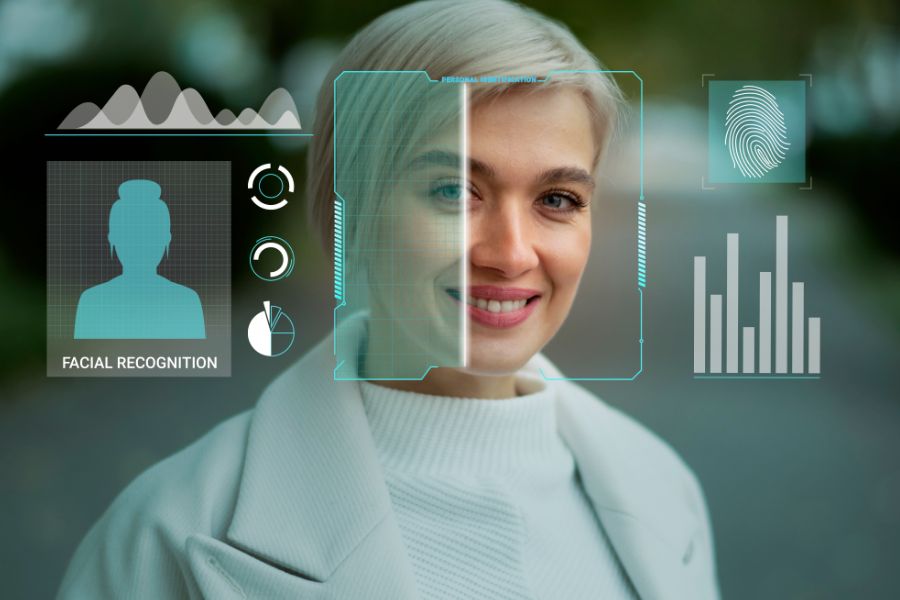Facial recognition software has rapidly evolved to become a game-changer in the landscape of modern point-of-sale (POS) systems. This technological synergy holds immense potential for revolutionizing customer transactions by introducing heightened security measures, personalized interactions, and streamlined operational efficiency. In this blog, we will delve into the practical applications of facial recognition in the context of contemporary POS systems, unraveling key insights into its effective implementation.
Join us on a concise journey as we explore the how-to aspects of integrating facial recognition software into modern POS systems and discover the practical benefits it brings to the forefront of seamless and efficient transactions.
What is facial recognition software? Key its features
Facial recognition software (FRS) is a biometric tool designed to compare faces within images, commonly sourced from photos and video stills, against a pre-existing identity database. The process involves three key components: detection (locating a face in an image), analysis (mapping facial features), and recognition (verification of identity).
A tangible illustration of facial recognition technology can be found in features such as auto photo tagging on platforms like Facebook or Google Photos. These social media and tech giants connect a user to a specific face in a photo by scanning their extensive database of uploaded images. Due to the intricate nature of facial features, surpassing the complexity of other biometric methods like fingerprints and iris scans, FRS tools rely on sophisticated artificial intelligence algorithms for accurate processing.
How does facial recognition software work?
Facial recognition software operates through a sophisticated process that involves technology and algorithms to identify and verify individuals based on their facial features.
Here is a step-by-step overview of how facial recognition software works:
- Face detection: The detection process is initiated by isolating the facial features from the input image provided to the system. Following this, distinct features on the human face are identified. Certain facial characteristics remain constant regardless of age or size, such as the distance between the eyes, the depth of the eye socket, and the shape of the nose. Approximately 80 of these consistent features, referred to as ‘landmarks,’ are identified. The measurements of these landmarks are then compiled to generate a code known as a ‘faceprint,’ a distinctive identifier unique to each individual.
- Matching: Subsequently, the generated faceprint undergoes comparison with the stored prints within the system. During this phase, the image undergoes multiple layers of technological scrutiny to guarantee precision. Given that the majority of our databases primarily consist of 2D photos, an additional layer of technology is applied to process the database images. This processing typically entails extracting facial landmarks to emulate their 3D equivalents. In cases where the subject image has low resolution, encoding and decoding are essential to produce details at the desired resolution. The algorithms employed must account for variations in lighting, facial expression, and angles to ensure accurate matching.
- Identification: The objective of this stage varies depending on the intended use of the facial recognition software, whether for surveillance or authentication purposes. Ideally, this step aims to establish a 1:1 match for the subject. Multiple approaches can be employed, starting with a rapid initial pass to narrow down potential matches, followed by the activation of more intricate layers. Certain companies enhance accuracy by analyzing skin texture in conjunction with facial recognition algorithms.
Every facial recognition software provider prioritizes distinct elements within the technology layers to deliver a nearly flawless service. For instance, one software might emphasize the correction of lighting conditions, while another concentrates on the analysis of skin texture.
Practical applications of facial recognition in Modern POS systems
Many people may wonder about the practical implementation of facial recognition in modern point-of-sale (POS) systems. In this part, we delve into the tangible applications of this technology and consider how it can be effectively applied in the realm of modern POS systems.
Customer identification and authentication
Facial recognition technology has revolutionized the way businesses identify and authenticate customers at the POS. Traditionally, identification processes relied on loyalty cards, membership numbers, or other physical identifiers. However, facial recognition takes this a step further, offering a seamless and secure method of customer verification.
With facial recognition, POS systems can recognize both potential and new customers. This allows businesses to provide a more personalized experience, as customer preferences and purchase histories can be instantly retrieved. The technology can be integrated with customer databases, enabling retailers to build a comprehensive understanding of their clientele.
Facial recognition payment system
One of the most groundbreaking applications of facial recognition in modern POS systems is in the realm of payment. Traditional payment methods involve cash, credit cards, or mobile payments, but facial recognition introduces a new level of convenience and security.
ConnectPOS, a leading POS solution provider, seamlessly integrates with third-party camera systems and payment providers to redefine the next-gen payment experience. By linking a customer’s facial features to their payment information securely, transactions become swift and secure. The system employs advanced algorithms to increase the accuracy and authenticity of the facial recognition process, making it a viable alternative to traditional payment methods.
Elevate the customer experience through tailored and customer-centric offerings
Facial recognition technology empowers retailers to elevate the customer experience by offering tailored and customer-centric products and services. By analyzing facial expressions and customer demographics, businesses can gain valuable insights into customer preferences.
For instance, if a customer frequently purchases a specific brand or product category, the POS system can use this information to recommend related items or offer personalized discounts. This level of customization not only enhances customer satisfaction but also increases the likelihood of repeat business.
ConnectPOS integrates with third-party facial recognition solutions to deliver real-time insights into customer behavior and preferences through its POS system. This enables retailers to create targeted marketing campaigns, loyalty programs, and promotions that resonate with their customer base.
Enhance in-store customer service through personalized assistance
In addition to tailored offerings, facial recognition in POS systems facilitates enhanced in-store customer service through personalized assistance. As customers approach the POS, their facial features can trigger alerts for store associates to provide personalized assistance or recommendations.
For example, if a high-value customer is identified, the system can notify staff to offer a more personalized and attentive service. This not only strengthens customer relationships but also contributes to a positive and memorable shopping experience.
The integration of facial recognition in POS systems aligns with the broader trend of leveraging technology to create a more customer-centric retail environment. By combining data analytics and facial recognition, businesses can anticipate customer needs and deliver a level of service that sets them apart in a competitive market.
Theft and shoplifting prevention
Retailers face significant challenges in preventing theft and shoplifting, which can lead to substantial financial losses. Facial recognition technology acts as a powerful deterrent and preventive measure in this regard.
Modern POS systems equipped with facial recognition can identify known shoplifters or individuals with a history of fraudulent activities. Alerts can be sent to store security personnel in real-time, allowing for immediate intervention. The mere presence of facial recognition technology serves as a deterrent, discouraging potential offenders from engaging in criminal activities.
By leveraging facial recognition for theft prevention, retailers not only safeguard their assets but also create a safer shopping environment for customers and staff. This aligns with the overarching goal of fostering a secure and trustworthy retail space.
Conclusion
In conclusion, integrating facial recognition software in modern POS systems represents a significant leap forward in redefining the retail landscape. From customer identification and streamlined payments to personalized customer experiences and theft prevention, the applications are diverse and impactful.
Get in touch with us to embrace the possibilities of facial recognition technology, and transform your POS system into a hub of seamless, secure, and personalized transactions.
ConnectPOS is a all-in-one point of sale solution tailored to meet your eCommerce POS needs, streamline business operations, boost sales, and enhance customer experience in diverse industries. We offer custom POS with features, pricing, and plans to suit your unique business requirements.




